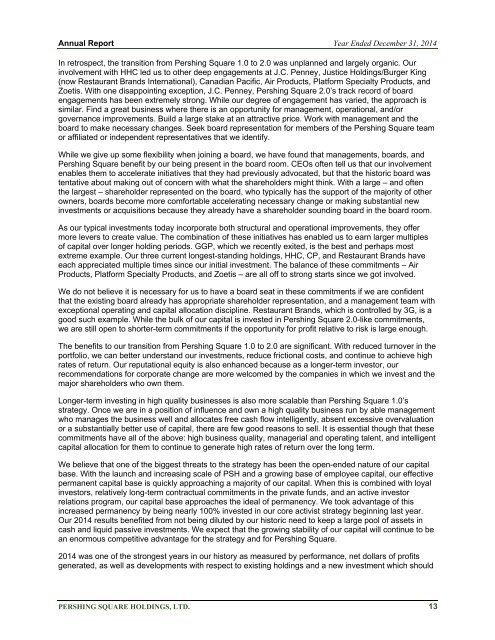PSH-Annual-Report
PSH-Annual-Report
PSH-Annual-Report
You also want an ePaper? Increase the reach of your titles
YUMPU automatically turns print PDFs into web optimized ePapers that Google loves.
<strong>Annual</strong> <strong>Report</strong> Year Ended December 31, 2014In retrospect, the transition from Pershing Square 1.0 to 2.0 was unplanned and largely organic. Ourinvolvement with HHC led us to other deep engagements at J.C. Penney, Justice Holdings/Burger King(now Restaurant Brands International), Canadian Pacific, Air Products, Platform Specialty Products, andZoetis. With one disappointing exception, J.C. Penney, Pershing Square 2.0’s track record of boardengagements has been extremely strong. While our degree of engagement has varied, the approach issimilar. Find a great business where there is an opportunity for management, operational, and/orgovernance improvements. Build a large stake at an attractive price. Work with management and theboard to make necessary changes. Seek board representation for members of the Pershing Square teamor affiliated or independent representatives that we identify.While we give up some flexibility when joining a board, we have found that managements, boards, andPershing Square benefit by our being present in the board room. CEOs often tell us that our involvementenables them to accelerate initiatives that they had previously advocated, but that the historic board wastentative about making out of concern with what the shareholders might think. With a large – and oftenthe largest – shareholder represented on the board, who typically has the support of the majority of otherowners, boards become more comfortable accelerating necessary change or making substantial newinvestments or acquisitions because they already have a shareholder sounding board in the board room.As our typical investments today incorporate both structural and operational improvements, they offermore levers to create value. The combination of these initiatives has enabled us to earn larger multiplesof capital over longer holding periods. GGP, which we recently exited, is the best and perhaps mostextreme example. Our three current longest-standing holdings, HHC, CP, and Restaurant Brands haveeach appreciated multiple times since our initial investment. The balance of these commitments – AirProducts, Platform Specialty Products, and Zoetis – are all off to strong starts since we got involved.We do not believe it is necessary for us to have a board seat in these commitments if we are confidentthat the existing board already has appropriate shareholder representation, and a management team withexceptional operating and capital allocation discipline. Restaurant Brands, which is controlled by 3G, is agood such example. While the bulk of our capital is invested in Pershing Square 2.0-like commitments,we are still open to shorter-term commitments if the opportunity for profit relative to risk is large enough.The benefits to our transition from Pershing Square 1.0 to 2.0 are significant. With reduced turnover in theportfolio, we can better understand our investments, reduce frictional costs, and continue to achieve highrates of return. Our reputational equity is also enhanced because as a longer-term investor, ourrecommendations for corporate change are more welcomed by the companies in which we invest and themajor shareholders who own them.Longer-term investing in high quality businesses is also more scalable than Pershing Square 1.0’sstrategy. Once we are in a position of influence and own a high quality business run by able managementwho manages the business well and allocates free cash flow intelligently, absent excessive overvaluationor a substantially better use of capital, there are few good reasons to sell. It is essential though that thesecommitments have all of the above: high business quality, managerial and operating talent, and intelligentcapital allocation for them to continue to generate high rates of return over the long term.We believe that one of the biggest threats to the strategy has been the open-ended nature of our capitalbase. With the launch and increasing scale of <strong>PSH</strong> and a growing base of employee capital, our effectivepermanent capital base is quickly approaching a majority of our capital. When this is combined with loyalinvestors, relatively long-term contractual commitments in the private funds, and an active investorrelations program, our capital base approaches the ideal of permanency. We took advantage of thisincreased permanency by being nearly 100% invested in our core activist strategy beginning last year.Our 2014 results benefited from not being diluted by our historic need to keep a large pool of assets incash and liquid passive investments. We expect that the growing stability of our capital will continue to bean enormous competitive advantage for the strategy and for Pershing Square.2014 was one of the strongest years in our history as measured by performance, net dollars of profitsgenerated, as well as developments with respect to existing holdings and a new investment which shouldPERSHING SQUARE HOLDINGS, LTD. 13


